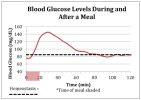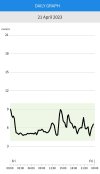craigieboy2001
Newbie
- Messages
- 2
- Type of diabetes
- Type 2
- Treatment type
- Diet only
Hi all,
I'm newly diagnosed with type 2 diabetes. I think I'm at the low end of of 'seriousness' at the moment so I've told the doctor I want to try and control it with diet first instead of Metformin. I can't quite get my head around sugar spikes at the moment though. So I have some questions if someone would be kind enough to answer them for me please My doctor is useless with explaining stuff (and that's putting it kindly!) and I haven't had a proper review with a diabetic nurse yet.
My doctor is useless with explaining stuff (and that's putting it kindly!) and I haven't had a proper review with a diabetic nurse yet.
1. I know that before meals my ideal mmol/l should be between 4 to 7 and two hours after should be below 8.5 mmol/l. But what about in between? For example, if I do a finger prick half hour after eating 'healthy' I notice my levels may have risen a couple of mmol's but if I eat a slice of cake or chocolate bar it may rise by as much as 5 to 6 mmol's. Does this matter as long as my levels go back down into the target range after the two hours or is there a maximum level my mmol should be between eating and the 2 hours after
2. After doing finger pricks for a few weeks I have noticed that my mmol hovers between 5-7 when I wake up and also when I take a finger prick before meals. It usually sits between 6-7 two hours after meals. Would this be classed as controlled diabetes? My HBA1C is 46
3. Am I allowed to have snacks between meals as long as it's under my calorie and carb intake for the day and am I ever allowed to indulge in a chocolate bar or a dessert / cake without taking medication or will this just spike me too high?
4 . I've read that daily ideal carb intake should be between 130-143g per day. I know they need to be 'good carbs' but is this amount ok if I'm not taking medication?
many thanks in advance!
Craig
I'm newly diagnosed with type 2 diabetes. I think I'm at the low end of of 'seriousness' at the moment so I've told the doctor I want to try and control it with diet first instead of Metformin. I can't quite get my head around sugar spikes at the moment though. So I have some questions if someone would be kind enough to answer them for me please
1. I know that before meals my ideal mmol/l should be between 4 to 7 and two hours after should be below 8.5 mmol/l. But what about in between? For example, if I do a finger prick half hour after eating 'healthy' I notice my levels may have risen a couple of mmol's but if I eat a slice of cake or chocolate bar it may rise by as much as 5 to 6 mmol's. Does this matter as long as my levels go back down into the target range after the two hours or is there a maximum level my mmol should be between eating and the 2 hours after
2. After doing finger pricks for a few weeks I have noticed that my mmol hovers between 5-7 when I wake up and also when I take a finger prick before meals. It usually sits between 6-7 two hours after meals. Would this be classed as controlled diabetes? My HBA1C is 46
3. Am I allowed to have snacks between meals as long as it's under my calorie and carb intake for the day and am I ever allowed to indulge in a chocolate bar or a dessert / cake without taking medication or will this just spike me too high?
4 . I've read that daily ideal carb intake should be between 130-143g per day. I know they need to be 'good carbs' but is this amount ok if I'm not taking medication?
many thanks in advance!
Craig


